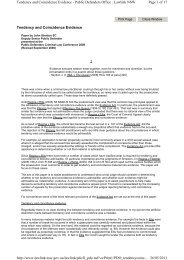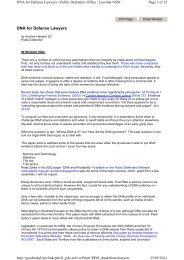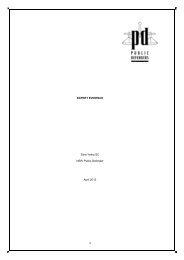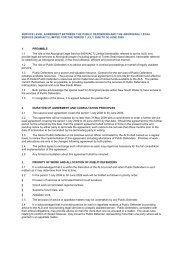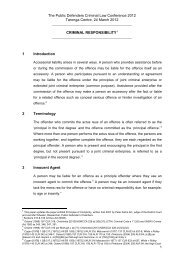Right to Silence: inferences from silence - The Public Defenders
Right to Silence: inferences from silence - The Public Defenders
Right to Silence: inferences from silence - The Public Defenders
Create successful ePaper yourself
Turn your PDF publications into a flip-book with our unique Google optimized e-Paper software.
inference) on the ground that her solici<strong>to</strong>r was affected by a conflict of interest as the<br />
representative of a co-accused. It was held that the proper course would have been <strong>to</strong> waive<br />
privilege and consider the matter fully on a voir dire: the court should not be asked <strong>to</strong><br />
speculate that the solici<strong>to</strong>r had acted improperly.<br />
A frequent outcome of consultation with a legal adviser is that the accused volunteers<br />
a prepared statement which is subsequently relied upon as demonstrating that he has<br />
‘mentioned’ those facts which form the basis of his defence at trial. If the statement<br />
proves incomplete, a particularly careful judicial direction may be required which may<br />
be complicated further by the fact that the statement was originally crafted on legal<br />
advice.<br />
Judicial direction as <strong>to</strong> permissible <strong>inferences</strong><br />
Where the fact is one which the accused could reasonably have been expected <strong>to</strong> mention it<br />
will be permissible <strong>to</strong> draw ‘such <strong>inferences</strong> <strong>from</strong> the failure as appear proper’ (s. 34(2)) in a<br />
variety of contexts including the determination of guilt (s. 34(2)(d), and whether there is a<br />
case <strong>to</strong> answer (s. 34(2)(c)), bearing in mind always that an inference drawn under the<br />
subsection is not by itself sufficient <strong>to</strong> sustain either determination (s. 38(3): see F19.6).<br />
Although the most common inference <strong>from</strong> failure <strong>to</strong> reveal facts which are<br />
subsequently relied on is that the facts have been invented after the interview, it may<br />
equally appear <strong>to</strong> the jury that the accused had the facts in mind at the time of interview,<br />
but was unwilling <strong>to</strong> expose his account <strong>to</strong> scrutiny (Milford [2001] Crim LR 330).<br />
Similarly, the jury may deduce that the accused was faced with a choice between on the one<br />
hand <strong>silence</strong>, and on the other either lying or incriminating himself further with the truth.<br />
Again, this is a permissible inference under s. 34 (Daniel [1998] 2 Cr App R 373).<br />
It follows that, even if it is common ground that an accused spoke <strong>to</strong> his solici<strong>to</strong>r about a<br />
proposed defence of alibi before any interview <strong>to</strong>ok place, his failure <strong>to</strong> reveal the alibi in<br />
interview was still a matter <strong>from</strong> which <strong>inferences</strong> could be drawn if the jury were<br />
unconvinced by the accused’s explanation (Taylor [1999] Crim LR 77).<br />
Where the inference which the prosecution suggests should be drawn is not the<br />
standard inference of late fabrication but is less severe, the judge should make this<br />
clear when summing-up (Petkar [2004] 1 Cr App R 270).<br />
In cases where the accused explains his failure <strong>to</strong> mention facts on the ground that he was<br />
acting on legal advice, but without explaining the reasons behind the advice, the trial judge<br />
should be particularly careful <strong>to</strong> avoid directing the jury in such a way as <strong>to</strong> indicate that the<br />
<strong>silence</strong> is necessarily a guilty one (Bresa [2005] EWCA Crim 1414).<br />
Direction where s. 34 applicable<br />
In all cases where the s.34 CJPO 1994 is <strong>to</strong> be relied upon, it is submitted that a clear<br />
judicial direction will be required as <strong>to</strong> the nature of the inference that may properly be<br />
drawn.<br />
Where prosecution counsel had not sought <strong>to</strong> rely upon s. 34, and had not raised the matter<br />
with the accused in cross-examination, the Court of Appeal in Khan [1999] 2 Archbold News<br />
2 rightly ‘deprecated’ the decision of the trial judge <strong>to</strong> direct the jury that they might draw an<br />
inference under s. 34 without first raising the matter with counsel. It was held, however, that<br />
K had suffered no disadvantage. It is submitted that this is a dangerous approach. A trial<br />
judge ought not, in fairness, <strong>to</strong> leave it open <strong>to</strong> the jury <strong>to</strong> make use of <strong>silence</strong> which,<br />
Colin Wells July 2013 Page 14



